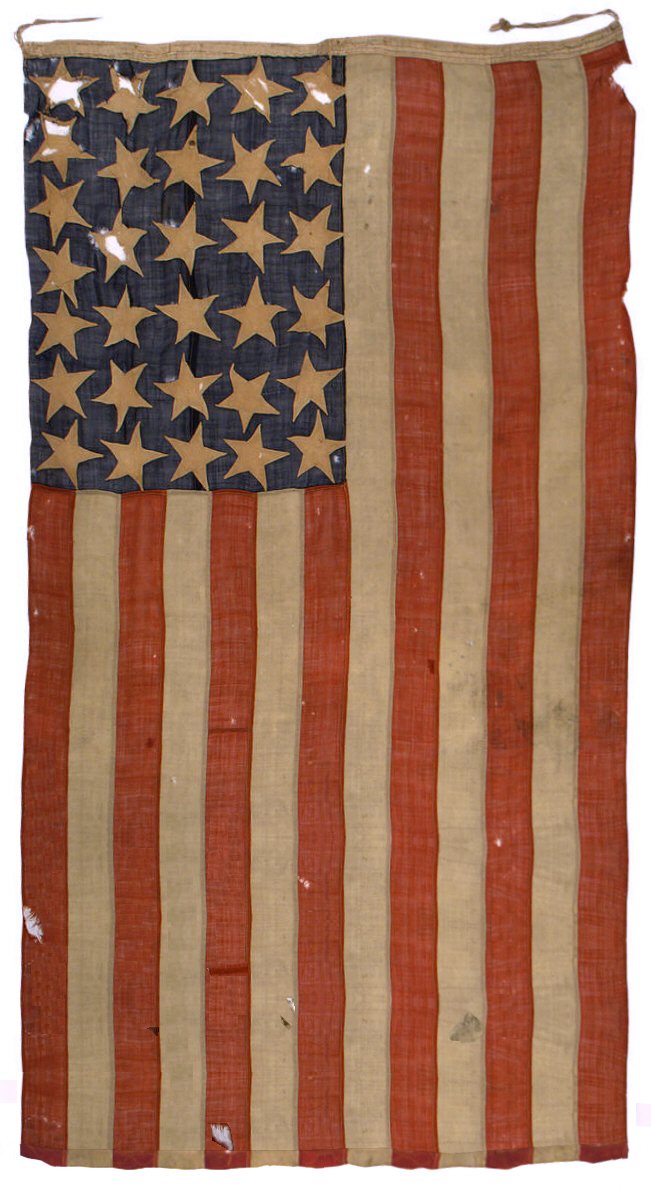
This flag is a rare and
beautiful example of an American Flag that predates the
Civil War. Flags that predate the Civil War are
extremely scarce. Fewer than one in a hundred
flags that survive from the 19th century were made prior
to the war. This flag was produced to celebrate
California's statehood in 1850. It dates to the
period California Gold Rush and the era of tenuous
compromises that failed to stem the inevitable Civil War
that threatened to rupture the nation.
The flag is in exceptional
condition for the period. The stars of the flag
are single-appliqué, with the more finished side on what
today would be considered the reverse of the flag.
The flag is the earliest that I have encountered that
features machine stitching. Remarkably, the entire
flag, including the single-appliqué stars, are machine
stitched. The chainstitches are indicative of the
earliest types of sewing machine. This trait is
remarkable for a textile of this early era, since sewing
machines were only just emerging in the decade of the
1850s. In fact, the discovery of this flag, with
its chainstitch construction, is an exception to earlier
research by Grace Rogers Cooper published in her
important study of thirteen star flags. She writes:
"Although some sewing
machines were patented in the 1840s and a few offered
for sale by 1849, the type of continuous feed needed to
make it practical to stitch even the stripes of the flag
by machine was not available until the early 1850s.
The variety of stitches that could be made by various
sewing machines can also be helpful in dating.
Since this variety was developed within a few years,
this information can only be used with a full
understanding of the capabilities of the machine and the
commercial use of the particular invention. For
example, although a chainstitch machine was manufactured
in France in 1830 and one was patented and marketed in
the United States in 1849, there was no practical
chainstitch machine available in this country before the
late 1850s. There is no evidence that the French
machine appeared in this country in the earlier years,
and the 1849 chainstitch machine patented in this
country was incapable of stitching the flat-fell seams
of a flag. As it happens, one rarely finds a flag
constructed on a chainstitch machine. All the ones
that are seem to have been made in this [the 20th]
century." - Grace Rogers Cooper, "Thirteen Star
Flags. Keys to Identification", Smithsonian Press,
1973, p. 24
The 31 stars of the flag are unusually large
and beautiful, completely filling the canton. They
rotate freely and are packed closely together with arms
interlocking in every direction. The canton of the
flag is made of two pieces of wool bunting, and the
third red stripe is made of three pieces of bunting.
The flag is nearly nine feet in length, but flags of
this period were typically much larger and primarily
used as a signal, flown on ships, on government
buildings, or above military forts. They were
seldom made for private use. Most sewn flags from
the period were often greater than ten feet in length,
and sometimes even twenty feet or longer.
Therefore this flag is actually reasonably small for the
period. The name "C. H. Hamilton" is found near
the canvas hoist on the fourth and sixth white stripe,
providing a personal touch to such a rare flag from the
era of California Statehood. |

